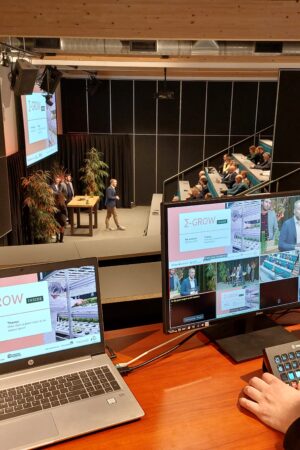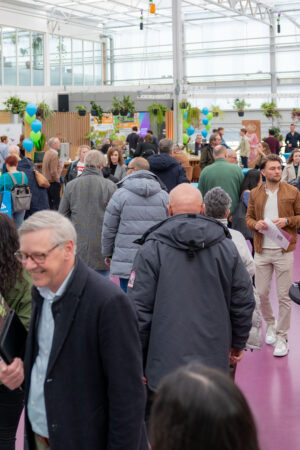Let us start with some company background information. “Fluence was founded in Austin, Texas, in 2013 by forward-thinking entrepreneurs Nick Klase and Randy Johnson, and was acquired in 2018 by Munich-based lighting manufacturer OSRAM. By combining Fluence’s proven leadership in LED-based horticulture lighting systems with OSRAM’s expertise in lighting technologies, sensors, and connectivity, Fluence further empowered growers worldwide to adopt scalable and highly profitable cultivation models that tapped into Fluence’s industry-leading research, products, and horticultural expertise. 2022 ushered in a new chapter of growth for the company, with Fluence’s acquisition by the world leader in lighting, Signify. Operating as a business unit within Signify’s Digital Solutions division, Fluence is reaching new heights in sustainable horticulture innovation, enabling growers to achieve even more efficient and productive economies of scale.”

Representing Fluence in the Cultivation for Compounds consortium is Sebastian Olschowski, a Research Project Manager at Fluence, where he is, according to the utilization of innovative lighting technology and latest laboratory methods, conceptualizing and coordinating cutting-edge research projects and grower trails in the EMEA (i.e., Europe, the Middle East, and Africa) region. Sebastian is specialized in the investigation of plant responses to different light spectra and intensities; with more than 10 years of holistic experience in multiple research- and practice-oriented disciplines within ornamental crops, leafy greens, vegetables, and medical plants such as cannabis.
Fluence’s company mission is to improve the interaction between light and life to yield a healthier and more sustainable world. In order to achieve that, Fluence creates lighting solutions for controlled environment commercial crop production. Nevertheless, Sebastian stressed that Fluence offers more than ‘just’ manufacturing lights; “We are not only a lighting manufacturer, and this especially applies when we talk about research. We are uniquely rigorous in our scientific experimental design and analysis that lead to the development of our products. By implementing established and formalized scientific research methods, we develop a far stronger understanding of how to optimize light for a given crop or production objective than what would otherwise be possible, and what is typical in the industry. We share a lot of knowledge with our partners and customers from what we have experienced in the past years. For example, in the CfC, we did not just install the lights and left them to be. We also give advice about how to acclimate the plants, how to modulate the light levels over time, and how to optimize irrigation strategies and fertilization, which is especially important when working with very high light intensities as in this consortium. That is why we are not ‘just’ selling lights, but also sharing knowledge and applying the special skills and experience of everyone in our team.”

We wondered what resulted in Fluence’s interest to join the CfC. Sebastian shared about the past experiences of Fluence with cannabis and mentioned that already in 2018, they started with cannabis research in the EMEA region. “There are multiple reasons why Fluence decided to join this long-term project, ” Shortly explained, it is a combination of research, knowledge expansion, a showcase of solutions for growers, and marketing reasons. The longer explanation reveals some interesting facts.
Sebastian explained the thoughts behind their research question; the CfC is conducted in a greenhouse, and unlike fully indoor facilities, in greenhouses growers are not used to having extremely high light intensities. Light intensity affects the amount of yield in cannabis production and with that the content of compounds that can be gained over a year-round growing cycle. Especially in greenhouses, high light intensities are still rare and currently go up to 600-800 µmol/m²/s maximum, which Fluence considers to be a standard. By adding 50% up and increasing the intensity to 1200 µmol/m²/s, Fluence expects a significant increase in yield and with that also an increase in produced compounds. Fluence installed for the CfC the VYPR fixtures and use a spectrum that is called R4, which is a broad white spectrum. Sebastian mentioned that it is a standard spectrum helping growers to achieve high yields without risking photobleaching or other things that might negatively impact quality or consistency. “In the end, we want to find out if having higher light intensities in the greenhouse can lead to year-round constant production regarding yield and compounds and next to this, we also wanted to showcase our light solutions.” In addition to that, Sebastian expressed the importance CfC being accessible to tour people and show them what is done as part of this consortium as well as the World Horti Center exhibition; “we are interested in showcasing our knowledge as well.” All these points mentioned come to a final goal at the end, Sebastian explained, it is “to have reliable results which can be shared with the growers and show that this consortium consists of excellent partners which know what they are doing.”
This led us to the next question. We wanted to know if Fluence experienced any struggles during the CfC and how they were solved. Sebastian reflected “As with almost every new project, which starts in a newly equipped facility, one can expect struggles and the CfC consortium faced them as well. Whenever you start something new, the first few attempts usually are there to learn how to run the facility in an appropriate way, being management of the environment (from temperature, CO2 and humidity, irrigation to fertilization, etc.), general maintenance of the crop, hygiene procedure and harvesting as well as drying processes up to internal and external communication about our mission. We, as the CfC team, are on a good path, improving and learning with every new cycle how to deal with circumstances in the facility. Us being thorough in that way ensures that at the end of the CfC consortium, we will leave a positive impact for future cannabis growers.”

Looking at the fact that the CfC is a long-term project, we were intrigued to know if Fluence has other plans regarding their research for the next years at the CfC. “For now, we will stay with our main question of light intensity, because we want to have a strong base and show that a year-round production with consistent quality is possible and higher amounts of light are both beneficial and economical to increase productivity and profitability in greenhouse applications. If we will manage to sufficiently achieve that prior to the end of the consortium, we are flexible to make any changes, as there are other things that are interesting to us to find out. For example, testing new cultivars starting from seeds, applying different crop training such as tipping compared to non-tipping, and of course, looking into the relation of what other parties are focusing on during the consortium (i.e., regarding different EC levels and water gifts or using different types of media, application of different IPM strategies, etc.). Maybe we will have a different light strategy, perhaps we will extend to see how this affects the propagation phase, or we go to completely different spectrum.” There are so many options, and it seems that Fluence is very open to changes, Sebastian confirmed, “It is good to be flexible in that and to be able to adapt depending on what we find out instead of set everything in advance until the very last day of this experiment.”
We continued the future-based discussion and asked Sebastian to share with us his thought about where Fluence will be at the end of this consortium, and what will be achieved. “I hope that, on the one hand, we will prove that we are able to produce a consistent quantity and quality throughout the entire year. That would be something that has not been shown in greenhouses yet for cannabis in Europe, and I think that will be a very big benefit for growers to be able to predict what they can sell later on to their customers. That is something I would like to see. In addition to that, I want to learnabout all the other partners and what they are doing. For instance, seeing what different EC levels are doing, what different water gifts are doing, if is there anything interesting happening when testing new IPM strategies, and more. So, the combination of all the different factors paired with the light is something that is interesting. I also believe that all the partners of the CfC will have good connections one with another.”
Sebastian concluded the interview noting once more that Fluence is more than a lighting manufacturer “We are not only a lighting supplier, but we also bring in a lot of cultivation knowledge and innovation, such as photo acclimation best practices, cultivation technology, wireless technology, full integration of multiple wireless sensors with the Priva computer through our wireless digital ceiling solution, and more.”
From this interview, it became clear that Fluence has many ideas and plans to develop, improve, and contribute to the cannabis industry in Europe and worldwide. Make sure to follow the progress of the CfC consortium, to among others, learn about the outcomes and future plans of Fluence.

* Cultivation for Compounds is partly funded by PPS surcharge for research and innovation from the Ministry of Economic affairs and climate.





